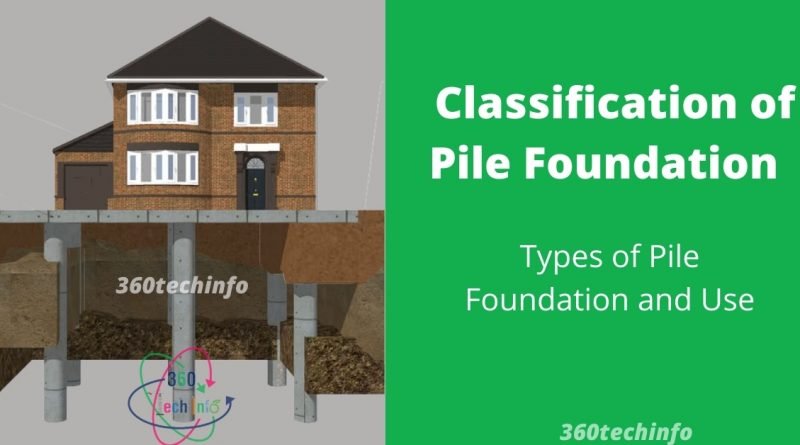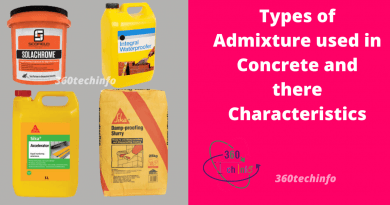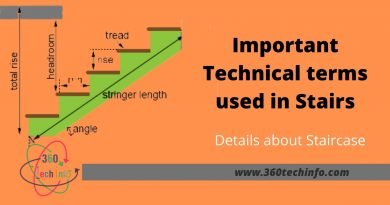Classification of Pile Foundation II Types of Pile Foundation and Use
As a type of deep foundation, pile foundations are classified various. Here in this article, we discuss the classification of Pile Foundation and their types.
Pile Foundation-
As a type of deep foundation, piles are slender columns or cylinders which are usually made of concrete or steel and used to support a structure and to transfer loads to desired depths by means of end bearings or skin frictions. Usually, pile foundations are used for large structures and to support structures in places where shallow soils cannot resist settlement or uplift. Here we will discuss the classification of Pile Foundation.
Classification of Pile Foundation are classified as under:
- Bearing piles (Load)–Bearing piles transfer the superimposed load through them to hard stratas at considerable depths.
- Friction piles-Friction piles transfer the superimposed load through them to the soft soil by the frictional forces developed between the ground soil and the surface of the pile.
- Battered piles- Battered piles are used to resist the inclined forces.
- Sheet piles- Sheet piles consist of thin members of steel sheet or timber.
- Under-ream piles-Under ream piles are provided bulbs known as under-reams, to increase the bearing capacity of the soil considerably.
Load Bearing Piles
1. Cast Iron Piles-
Cast iron piles are hollow tubes of cast iron having an inner diameter of 20 to 40 cm and wall thickness 20 to 30 mm. These are generally 4 meters in length and for longer lengths, these are joined by a suitable device. Cast iron being a brittle material, these piles are provided with helical screws at the lower end and the whole assembly is rotated to drive the pile inside the soil. Piles with helical screws are generally known as screw piles.
Cast iron piles are suitable for shallow foundations and are suitably employed for the foundations of marine structures, lightweight bridges and buoys anchors.
2. Cement concrete piles-
These are Classification of Pile Foundation in the following-
(A) Cast-in-situ piles-
These piles are cast with cement concrete at the place where they have to carry the superimposed load. For casting the pile, a hole is driven by excavating with an Auger or driving a casing. The hole is then filled up with cement concrete. As these piles are generally driven vertically, no reinforcement is needed. If the casting is left in position, the pile is known as a cased cast-in-situ concrete pile and if the case is withdrawn, the pile is known as an uncased cast-in-situ concrete pile.
The uncased cast-in-situ concrete piles are of the following types:
Simplex pile- A hollow cylindrical steel casing with a one-pointed iron shoe attached to its bottom is driven into the ground to the desired depth. Concrete is then poured into the casing pipe for a depth of about one meter and compacted. The casing pipe is lifted up for a distance of one meter. In this way entire length of the hole is filled up with compacted concrete which acts as a pile.

Frankie – It consists of an enlarged base and corrugated stem. Initially, 60 cm to 90 cm bottom portion of the casing pipe is filled with concrete and compacted by dropping a hammer to provide a solid plug at the end. The casing is then driven in by hammering the concrete plug till it reaches the desired depth. Now the casing is lifted to a small distance and the concrete is forced by the hammer blows. Successive layers of concrete are then poured and compacted, and simultaneously the casing is lifted.
Pedestal Pile-A concrete pile with a pedestal at the bottom end is known as a pedestal pile. The pile may consist of plain cement concrete or reinforced cement concrete.
Pressure pile- A pile which is made by pouring cement concrete inside a casing pipe in layers of 30 cm, and each layer being compacted by compressed air, is called a pressure pile. The casing is gradually lifted. Such piles can resist shocks and vibrations to a greater extent.
Vibro pile-A hollow steel tube with a cast iron shoe at its bottom is driven into the ground to the desired depth. The casing is filled with fresh cement concrete. The casing is then removed by pulling upward and hammering downward. Such piles arc cast with a rapid speed and generally these consist of dense and uniform concrete.
Under-reamed pile– In soils that experience alternate swelling and shrinkage due to changes in its moisture content, under-reamed piles are used for transferring heavy loads. Under-reams are provided at distances 1.50 apart, where is the diameter of the bulb. The number of reams is decided according to the load, the foundations are supposed to carry.
(B) Cased cast-in-situ concrete piles–
The cast-in-situ concrete piles in which casing is left in the ground, are of the following types:
Raymond pile-In this type of pile, a corrugated thin steel sheet tapered shell is driven into the ground with a collapsible steel mandrel inside it to the desired depth. The reinforcement cage is inserted into the sheet and cement concrete is poured into it. These piles are suitable for lengths varying from 6 to 15 meters.
Monotube pile-In this type of pile, a tapered steel shell without any mandrel is used as a casing. It is driven into the ground to the desired depth. A reinforcement case is inserted into the shell and cement concrete is then poured into it.

Mac-Arthur pile- In such piles, heavy steel casing is driven into the ground with a core inside it to the desired depth. The core is then pulled out and a corrugated steel shell is inserted. Finally, cement concrete is poured and the outer casing is withdrawn.
Button bottom pile- In such piles, a button-shaped bottom is used at the lower end of the steel casing which is driven into the ground to the desired depth. A corrugated steel shell is lowered into the steel casing. The steel casing is removed and cement concrete is poured into the shell.
3. Sand piles–
In this type of pile, holes are driven into the ground to the desired depth, and sand is filled in the holes. Such piles improve the bearing capacity of the soil. If instead of sand, gravels are used the piles are called gravel piles.
4. Timber piles-
In this type of pile, piles of hard and strong timber pile carry a cast iron shoe and the upper end is provided with a steel plate to receive hammering stress. If a number of timber piles are used their tops are provided with a concrete cap known as a pile cap.

5. Steel piles-
Steel piles may be either H-piles, box piles, or circular tube piles.
H-piles -These piles are suitably used in hard soil by driving to the desired depth by hammering. These are generally used in retaining walls.

Box piles-These piles are generally rectangular, square or octagonal in shape. These consist of deep beams which offer adequate frictional resistance and end resistance.
Circular tube piles– These piles consist of circular steel tubes driven into the ground to the desired depth. From the open-ended pile, the soil is removed and cement concrete is poured.
6. Wrought iron Piles-
These piles are generally solid and circular, having diameters ranging from 80 to 200 mm. Their normal length is between 4 to 6 meters. These are especially suitable as shafts for screw piles.
7. Composite Piles-
These piles are a combination of a bored pile and a driven pile or of driven piles of two different materials. A combination of timber and cement concrete is generally preferred.
CONCLUSION-
Do you think this post Classification of Pile Foundation is useful for you or the post is informatics. Then please comment and share the post with your friends your one share can give us the motivation to create such a post. If there are any new input or updates needs please comment below to improve them. Thank you for connecting with us. Join our Telegram Channel.





